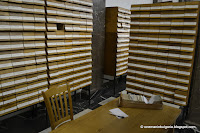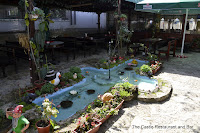Day Three, churches, monuments and libraries
Leaving the church I continued my way up bul. "Tsar Osvoboditel" rather than retracing my steps to the Cathedral. Passing the Military Club and the Italian and Austrian Embassies I halted beside a cream building where the road gave way to the wide and imposing pl. "Narodno sabranie". I have to say that the 'Monument to Liberators, the 'National Building' and the University opposite are all overshadowed by the 5 star Raddison Blu. A fine location for them but I wonder what was knocked down? Looking to the left up ul. "15-ti noemvri" reveals another magnificent aspect of the cathedral. Before moving on into the square I took a couple of photographs, one of the street sign named after the man on the horse displayed in Bulgarian and English and the other of what appears to be the Bulgarian equivalent of our 'Blue Plaque'. Both on the wall of what turned out to be the home of the Bulgarian Academy of Sciences.
As I was captioning the photos I decided to translate the name on the plaque, the dates being obvious. Having translated the name I was curious as to why he deserved a plaque and I learned another little piece of history. 'Marin Drinov' was a Bulgarian historian and philologist (look it up) who was educated in Russia. Amongst other things it was he who, as Minister of Popular Enlightenment and Spiritual Affairs proposed Sofia rather than Tarnovo as the Capital City of the new Bulgarian state. Tarnovo 'the city of the Tsars' had been capital of the Second Bulgarian Empire and favoured by Austria. He was also a founding member of said Academy of Sciences then the Literary Society.
Crossing to the centre of the square I examined and took several photographs of the 'Monument to the Liberators' I was enthralled by the detail on these bronze castings and the almost life size drama portrayed there. Once again history reveals itself as the Russian troops and Bulgarian volunteers drive out the Ottoman Empire which had ruled Bulgaria for five centuries until 1878. Tsar Alexander II of Russia holding the declaration of war sits atop his steed at the pinnacle of the monument. Designed by the Italian sculptor Arnaldo Zocchi, the winged 'Nike', Greek goddess of victory leads the charge. Did they get free trainers I wonder?
I took a photograph of the front façade of the Neo-Renaissance style National Assembly building. As I am not a member of parliament I couldn't get inside. Crossing the square I popped into the Raddison to use a 5 star loo then wandered off in the direction of the University of Sofia. Contrasts in architecture caught my eye as I went. Ah ha, one doesn't cross the road to the university but descends into the pedestrian underpass which also happens to be the home of a metro station amongst other things. One being the Cultural Information Centre Sofia. I thought that I would try them to see if I could gain admission to the National Theatre building.
My first employment was with Durham County Library Service. In those days card indexes and 'Dewey' reigned supreme. My father bought me a typewriter so that I could practice! What has this to do with Sofia you may ask? Follow the trail of photographs in the album and you will find that we have entered the hugely impressive National Library Building where I was kindly shown around by the Public Relations Officer, ah I wish I was younger I could have compared indexes late into the night. There are four floors and miles of books, magazines, newspapers, photographs and documents housed here. Computerisation took over about ten years ago it my memory serves me correctly but for a collection of this scale card indexes appear in every nook and cranny. There are English and other foreign language books here too. The library also organises themed exhibitions in its main hall from the vast collection too.
Stopping for lunch in the the park I wandered around the exterior of the Cathedral before entering the building. Again photography is not allowed and would not have been very successful. It was very dark inside, after such spectacular exterior I was underwhelmed. Perhaps sunlight through the stained glass windows set high in the domes would have raised my spirits but this was winter and, despite the candles, the gloom persisted. I decided to head off to find the Symphony Hall to purchase my concert ticket. Crossing the square I found that I was at the business end of the two embassies I had walked past earlier then back down to the monument, a different view. It took me ages to find the Concert Hall.
After all of the architectural splendour the building looks like an office block buried away down a side street. Nothing is ever in vain. I discovered the reconstruction of the Grand Hotel Sofia and the history of the city and the hotel displayed on billboards erected to protect the pedestrians. The building has been taken over by a bank, the front fascia is preserved with the grand entrance but modern steel girders and brickwork are now the backbone of the building. It was near freezing at ground level, I don't know how cold the construction workers in their tower crane bucket felt as they swung through the air from one end of the building to the other.
I walked across to the National Gallery intending to have a look at the visiting exhibition however I had purchased tickets for the Ethnological Museum housed alongside the Picture Gallery in what was once the palace of the king, a relation of Prince Philip. I was in the domestic wing of the building, the queens bedroom and reception room amongst others. There is no permanent collection here, the museum displays visiting collections from the regions. My English speaking guide proved most knowledgeable and explained how and when the various costumes were worn. Thus I gained knowledge of local traditions and customs especially those of betrothal and marriage. Whilst discussing the mummers costumes and traditions she mentioned a festival to be held at the end of January at a place near Sofia. This would lead to another adventure here in Bulgaria.
The museum closed and I departed. Coffee and a snack at the Grand Hotel on the other side of the City Garden which was obviously, at the time, the playground of the royal family. Then into the Bulgaria Concert Hall. The unassuming exterior belies the hall itself. Constructed in the 1930s it is the home of the 120 piece Symphony Orchestra. I took my seat up in the gods, the orchestra would be performing to a packed house. My neighbour occupied two rows and three seats. A national TV camera! The orchestra entered, the lights dimmed and the performance began.
I recognised the first piece and the second confirmed it, Handel's 'Messiah'. Strange, it is normally performed at Easter in England. No matter, excellent acoustics, excellent performers I was pleased that I had found the tickets. At the interval I managed to speak to the cameraman. The performance would be broadcast on national TV in April 2016. Once again I was swept back in time to those occasions when Durham Cathedral would be decked out with Christmas trees and holly for the service of 'Nine Carols' to be broadcast at Christmas of course. Churches all over the city would provide choirs to make up the congregation and this all took place at the height of summer. TV is the same the world over it would seem.















Comments
Post a Comment